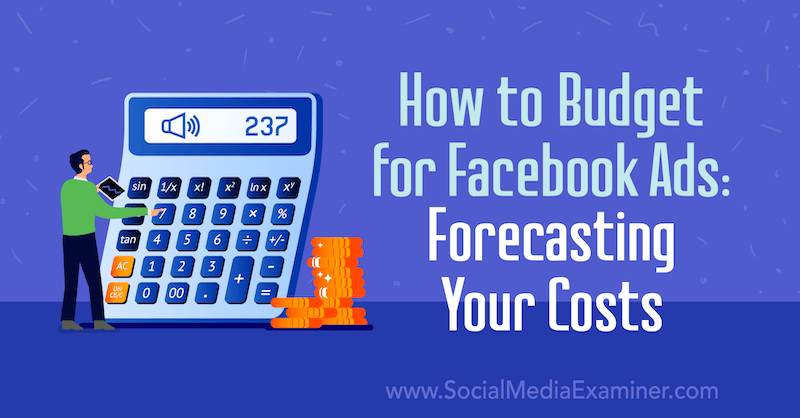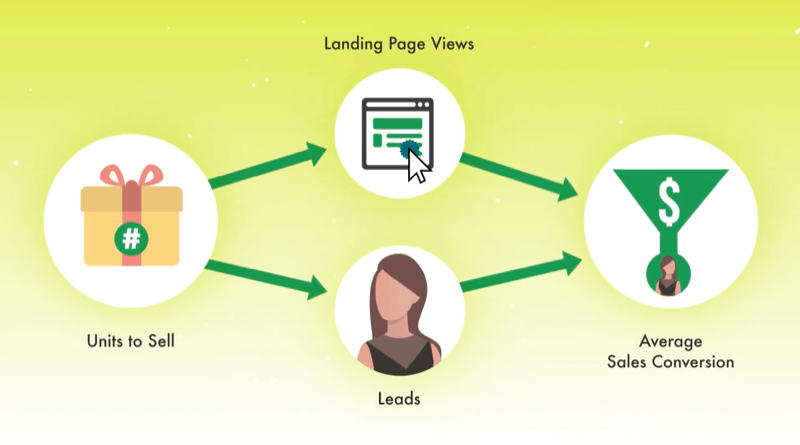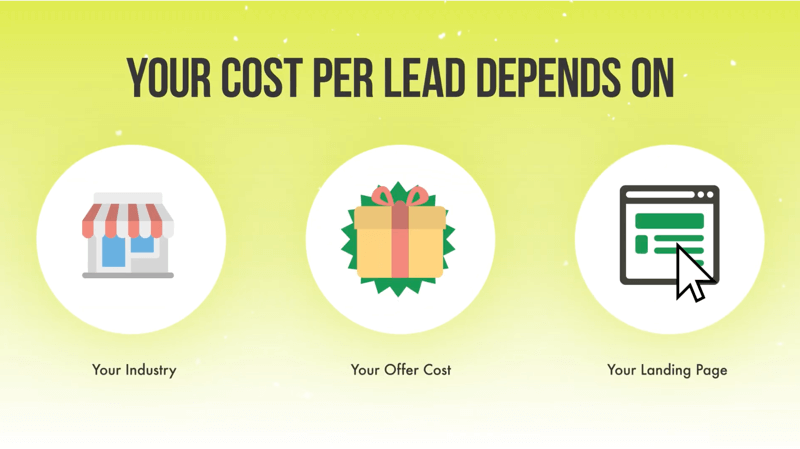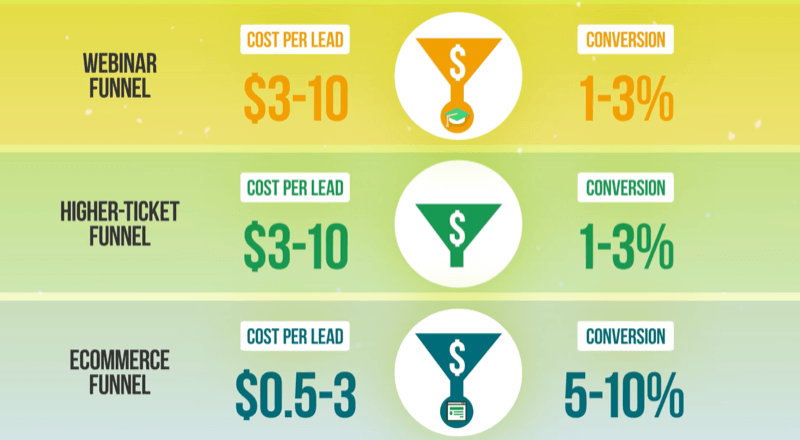Do you use Facebook ads? Wondering how to accurately forecast your ad spend?
In this article, you'll discover a simple formula that will help you budget your Facebook ad spend.

To learn how to calculate your Facebook ads budget based on your sales goals, read the article below for an easy-to-follow walkthrough or watch this video:
#1: Define Your Sales Goals
The first step in setting your Facebook ad budget is to determine how much revenue you want to generate from your Facebook ads in the next 30 days.
Once you have a revenue goal in mind, calculate how many units you need to sell. To arrive at this number, divide your total revenue by the cost (or average cost) of your offer.
Revenue Goal ÷ Cost of Offer = Units to Sell
For example, if you want to make $10,000 in the next 30 days running Facebook ads and your product sells for $1,000, you would need to sell 10 units of that product.
$10,000 ÷ $1,000 = 10 Units to Sell
#2: Determine How Many Leads You Need From Your Facebook Ads
Once you know how many units you need to sell to achieve your sales goal, the next step is to calculate how many landing page views or leads you need from your Facebook ads. To do that, you need your average sales conversion.

We're going to walk through a couple of industry averages, but if you have your own data from anything you've previously done, plug that into this formula.
Email Leads
If your business is set up to get email leads and you sell to customers through a webinar or video series, you need to determine how many email leads you need to achieve your sales goal.
To calculate this number, you'll need to come up with a sales conversion of those leads. We're going to use a 5% sales conversion to make it easy. If you have an expensive product, you'll have a lower sales conversion. If you have an inexpensive product (under $300), you might have a higher sales conversion. Feel free to adjust this for your business.
Get World-Class Marketing Training — All Year Long!
Are you facing doubt, uncertainty, or overwhelm? The Social Media Marketing Society can help.
Each month, you’ll receive training from trusted marketing experts, covering everything from AI to organic social marketing. When you join, you’ll also get immediate access to:
- A library of 100+ marketing trainings
- A community of like-minded marketers
- Monthly online community meetups
- Relevant news and trends updates
Now take the number of sales (which you calculated above) and divide that by the sales conversion you've chosen.
Number of Sales ÷ Sales Conversion = Leads
So for our example, divide 10 by 5%. Now you know you need 200 email leads to meet your goal.
10 ÷ 5% = 200 Leads
Landing Page Views
If you run ads that take people straight from your ad to your product, you have to calculate how many landing page views you need. Let's say 7% of all of the people who land on your sales page buy your product. So take your sales goal and divide it by 7%.
10 ÷ 7% = 143 Landing Page Views
You'll need approximately 143 people to land on your page to generate 10 sales of your product.
#3: Calculate Your Facebook Ad Spend Budget
The last step is determining your Facebook ad spend budget. To calculate this, multiply the number of leads you need by the cost per lead. Or multiply the number of landing page views by the cost per landing page view.
Number of Leads x Cost per Lead = Ad Spend Budget
Number of Landing Page Views x Cost per Landing Page View = Ad Spend Budget
Don't worry if you don't know your average cost per lead. It can range anywhere from $2-$10 depending on your industry, how much your offer is, and what you're sending them to.

Let's start with the lead example, using a $4 cost per lead. Multiply 200 leads by $4 to determine your ad spend.
200 x $4 = $800 Ad Spend Budget
You need to spend $800 on your ads to get those 200 leads.
For the landing page view example, the average landing page view cost is $0.50-$3. So if you multiply 143 by $1, you'll discover you need to spend $143 on your Facebook ads.

Discover Proven Marketing Strategies and Tips
Want to go even deeper with your marketing? Check out the Social Media Marketing Podcast! Publishing weekly since 2012, the Social Media Marketing Podcast helps you navigate the constantly changing marketing jungle, with expert interviews from marketing pros.
But don’t let the name fool you. This show is about a lot more than just social media marketing. With over 600 episodes and millions of downloads each year, this show has been a trusted source for marketers for well over a decade.
143 x $1 = $143 Ad Spend Budget
#4: Adjust Your Facebook Ad Cost
Now that you've calculated your Facebook ad spend budget, what if you don't want to spend that much money on your ads? You can simply adjust your numbers to settle on a budget that works for you.
Following this same process, go back and tweak your figures until your sales goal matches a reasonable ad spend goal. That's why you want to do this before running ads. It will stop you from boosting posts or throwing things out there and hoping they work because you're going into this very intentionally (“I'm going spend $800 to make $10,000”).
Suppose that instead of selling 10 of your courses, you set your goal at 100. You want to generate $100,000 in revenue in the next 30 days by selling those courses.
To sell 100 courses at a 5% sales conversion, you need 2,000 leads.
100 x 5% = 2,000 Leads
At an average cost per lead of $4, your ad spend will be $8,000.
2,000 x $4 = $8,000 Ad Spend Budget
Keep tweaking these numbers until your budget aligns with your sales goal and is an amount you're willing to spend.
If your budget seems too high, you can decrease your sales goal or play with your conversion numbers to get it to a place where it matches what you're willing to spend today.
On the flip side, if you get here and your budget is too low and you're willing to spend more, increase your budget and you'll also be able to increase your sales goal.
Pro Tip: Make sure your Facebook ad budget is at least $500. Anything less than that isn't really worth it and you won't get the traction you need.
Bonus: Determining Your Average Cost per Lead and Conversion Rate
When planning out these metrics, there are a few things to take into consideration depending on your business and industry.
In terms of average conversion rates, business-to-consumer (B2C) marketing is very different from business-to-business (B2B) marketing.
Generally in the B2C space, your cost per lead and cost per landing page view will be on the lower end of the averages and your sales conversion will be a little bit lower too. Consumers usually need a few more touchpoints with your brand and they're a little bit harder to sell to.
But in the B2B space, you'll probably pay a higher cost per lead. You might be on that higher end of the industry averages, but if you successfully get someone to your landing page or webinar, your sales conversion will be higher.
Average Cost per Lead and Conversion Rate for 3 Types of Sales Funnels
Now let's talk about what these metrics mean for a few specific funnels.
We'll start with the webinar funnel. An average cost per webinar registration is $3-$10. If you're in an industry targeting consumers, again you'll probably be at the lower end. And if you're targeting business owners, you'll probably be on the higher end.
Next, let's look at a high-ticket sales funnel where you're selling to people through a call or an application into your higher-level service. In this sales funnel, typically 1%-3% of your leads will actually purchase. And how you're getting them to that call might vary. So if you're using a webinar, you'll fall within the $3-$10 average cost per webinar registration as well.
And finally, with an eCommerce funnel, you'll pay an average of $0.50-$3 for a landing page view and you should be converting 5%-10% of that traffic. This would also be relevant to a self-liquidating offer funnel if you have a very low-priced digital product and you're going straight from your ad to your product.

Conclusion
Following this simple Facebook ad budget formula will help you determine how much you'll need to spend on Facebook ads to meet your sales goals. If you come up with a number that's more than you're willing to spend, go back and tweak the numbers to settle on a budget that works for your business.
Get More Facebook Ads Advice:
- Discover a proven Facebook ad testing method designed for small budgets.
- Learn a process for using Facebook ads to turn leads into paying customers.
- Find out how to identify Facebook ads you should stop spending money on.
Attention Agency Owners, Brand Marketers, and Consultants

Introducing the Marketing Agency Show–our newest podcast designed to explore the struggles of agency marketers.
Join show host and agency owner, Brooke Sellas, as she interviews agency marketers and digs deep into their biggest challenges. Explore topics like navigating rough economic times, leveraging AI, service diversification, client acquisition, and much more.
Just pull up your favorite podcast app, search for Marketing Agency Show and start listening. Or click the button below for more information.

